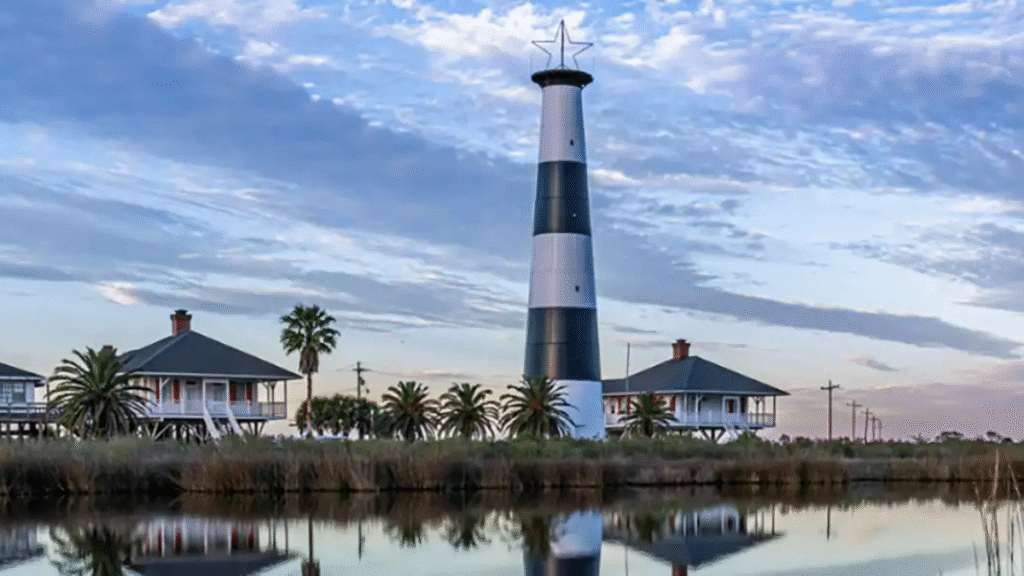From Galveston to Port Isabel
The history of Texas lighthouses runs deep, starting back in 1852 when the federal government built more than 20 beacons to help ships navigate the shallow waters, shifting sandbars, and hidden oyster reefs of the Gulf of Mexico. Over the years, many were lost to powerful storms, relentless beach erosion, or outright demolition. Only a handful managed to stand the test of time. Today, just six Texas lighthouses remain — each a weathered witness to the state’s maritime past.

These towers were once manned by dedicated lightkeepers but faced constant threats. During the Civil War, all navigational operations ceased as Union forces blockaded Texas ports. Both Union and Confederate troops used the towers as lookouts, and in some cases, Confederate soldiers intentionally damaged them to prevent Union use. Over the decades, hurricanes, fires, saltwater corrosion, and shifting shorelines claimed many more.
By the mid-20th century, new technology—automated foghorns, radio beacons, and electric lights—made the job of lightkeepers obsolete. Today, the surviving beacons stand at Matagorda Island, Aransas Pass, Port Bolivar, Sabine Pass, and Port Isabel, with Port Isabel Lighthouse now a state historic site and the only one in Texas open for the public to climb.
Stop 1: Point Bolivar Lighthouse - Bolivar Peninsula
We’re starting with a ferry ride from Galveston over to Bolivar Peninsula, and right away you’ll spot our first stop — the Point Bolivar Lighthouse.
This 117-foot black iron tower was built in 1872 and has stood through some of the worst storms in Texas history. In the deadly hurricane of 1900, over a hundred people took shelter inside its thick walls.
It’s privately owned now, so you can’t go inside, but from Highway 87 you can still see it standing tall and a little eerie. With its weathered frame and rusted shell, it has that perfect “ghost story” vibe — and locals will tell you it’s haunted. Standing there, it’s not hard to believe them.
Stop 2: Halfmoon Reef Lighthouse
Our next stop is unlike any other — the Halfmoon Reef Lighthouse. Built in 1858, it’s a rare screw-pile lighthouse, which means it stood on metal legs out in Matagorda Bay like a giant crab.
Today, it’s been moved onto dry land in Port Lavaca and restored so visitors can step inside. Instead of a spiral staircase and towering lantern room, you’ll find cozy living quarters where keepers once braved storms and hurricanes. It’s one of the last of its kind in the country, making it a must-see for lighthouse lovers.
Stop 3: Matagorda Island Lighthouse-Matagorda island
This one feels like it belongs in an old adventure movie. The Matagorda Island Lighthouse was first built in 1852, rebuilt in 1873, and stands 91 feet tall on a remote, uninhabited island.
Getting here isn’t easy — you’ll need a boat and a taste for adventure — but even seeing it from the water is worth the trip. Imagine the lighthouse keepers who once lived here, miles from anyone, with nothing but the crash of the waves and the flicker of the lantern to keep them company.
Stop 4: Lydia Ann Lighthouse- Near port Aransas
A little farther down the coast, you’ll find one of the prettiest lighthouses in Texas — Lydia Ann Lighthouse, also called the Aransas Pass Light Station. Built in 1857, this 68-foot red brick tower sits on its own little island.
You can’t walk right up to it since it’s privately owned, but boat tours and dolphin cruises will take you close enough to really appreciate its beauty. After going dark for 37 years, it was restored and relit in 1989. Catch it at sunrise, and you’ll see why it’s a favorite among photographers.
Stop 5: Frazier Lighthouse
Our next stop is a modern surprise. The Frazier Lighthouse in Corpus Christi isn’t here to guide ships — it’s here to make a statement. Standing 142 feet tall, it’s the tallest lighthouse in Texas and was completed in 2023 as part of the Lighthouse Pointe apartment complex.
Its light changes colors for holidays and special events, making it a striking feature against the coastal skyline. You can’t climb it, but it’s worth pulling over for a few photos — especially at night when it’s lit up.
Stop 6: Port Isabel Lighthouse – Port Isabel
For our final stop on this Texas lighthouse road trip, we head south — way south — to the only lighthouse in Texas that’s open to the public. Port Isabel Lighthouse, built in 1852, rises 72 feet above the Laguna Madre Bay. It’s a brick beauty with 75 winding steps to the top, and trust me, the views are worth the climb.
During the Civil War, both Union and Confederate troops used it as a lookout, but now it’s all about history and those killer Gulf views. The old Keeper’s Cottage next door has been turned into a small museum with artifacts from its past.
Tip: If you time your visit for sunset, you might get that perfect orange-and-pink sky — just be ready for some strong winds up there.
As the miles roll by and the salty air lingers in your hair, you start to realize this Texas lighthouse journey isn’t just about the towers themselves — it’s about the stories they hold. From standing in the shadow of Point Bolivar’s weathered iron giant to watching the red brick of Lydia Ann glow in the morning sun, each stop feels like a step back in time. These beacons may no longer guide ships the way they once did, but they still light the way for travelers like us, connecting the present to the rugged, resilient spirit of Texas’s coast.
Until Next Time !
Susan
My Final Thoughts
This Texas lighthouse road trip proves you don’t have to go to Maine or the Outer Banks to find incredible coastal history. From haunted iron towers to modern skyline landmarks, and from remote island beacons to quaint cottage-like lights, each one has its own personality and story.
If you’ve got a few days, a good playlist, and a love for the sea, this route is one for the bucket list. Just be warned — after seeing these, you might start planning your next lighthouse trip before you even get home.

